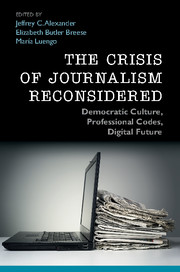Book contents
- Frontmatter
- Dedication
- Contents
- About the Contributors
- Preface
- Acknowledgments
- Introduction: Journalism, democratic culture, and creative reconstruction
- PART I THE CRISIS NARRATIVE
- PART II FEARS OF DIGITAL NEWS MEDIA: THE SYMBOLIC STRUGGLE
- 6 When codes collide: Journalists push back against digital desecration
- 7 Telling the crisis story of journalism: Narratives of normative reassurance in Page One
- 8 Assembling publics, assembling routines, assembling values: Journalistic self-conception and the crisis in journalism
- 9 The constancy of immediacy: From printing press to digital age
- 10 News on new platforms: Norwegian journalists face the digital age
- PART III PROFESSIONAL JOURNALISM, CIVIL CODES, AND DIGITAL CULTURE
- Conclusion: News innovations and enduring commitments
- Index
- References
9 - The constancy of immediacy: From printing press to digital age
from PART II - FEARS OF DIGITAL NEWS MEDIA: THE SYMBOLIC STRUGGLE
Published online by Cambridge University Press: 05 June 2016
- Frontmatter
- Dedication
- Contents
- About the Contributors
- Preface
- Acknowledgments
- Introduction: Journalism, democratic culture, and creative reconstruction
- PART I THE CRISIS NARRATIVE
- PART II FEARS OF DIGITAL NEWS MEDIA: THE SYMBOLIC STRUGGLE
- 6 When codes collide: Journalists push back against digital desecration
- 7 Telling the crisis story of journalism: Narratives of normative reassurance in Page One
- 8 Assembling publics, assembling routines, assembling values: Journalistic self-conception and the crisis in journalism
- 9 The constancy of immediacy: From printing press to digital age
- 10 News on new platforms: Norwegian journalists face the digital age
- PART III PROFESSIONAL JOURNALISM, CIVIL CODES, AND DIGITAL CULTURE
- Conclusion: News innovations and enduring commitments
- Index
- References
Summary
The newspaper crisis has raised considerable concern about the quality of daily news in the United States. Fears about the decline of watchdog journalism have been sounded as newspapers cut investigative staff, slash State House and Washington bureaus, and turn to more banal, audience-pleasing local news in an effort to capture Web attention. Books, whitepapers, and essays have maligned the erosion of what Alex Jones (2009) of Harvard's Shorenstein Center calls the “Iron Core” of journalism – quality, public interest journalism. Much of the discourse about the state of journalism takes place at a macro level, rather than through a lens that focuses on the working conditions of journalists in newsrooms today. But to understand the full picture of just how to assess the crisis of journalism, it's important to also consider the process of news production itself. A study of news production offers a perspective beyond what gets said and written in public discourse, and instead looks at how journalists’ work practices may be influenced by digital change, and, perhaps, crisis.
Too simply put, the causes of the crisis are too often placed in technological and economic terms. For example, The Internet has caused the newspaper crisis, and without this technology none of what we see today would have happened. Or, the current crisis is the result of a failure of the traditional business model in the digital age, and now we can trace all decisions about journalism to economics. There is, however, a cultural component to this crisis that must be considered, one that connects journalism beyond this particular moment to a longer history of news itself. The economic and technological causes and effects of the crisis are indeed real, but these factors cannot be explained without contextualization in the practices and profession of journalism itself.
Notably, there are others, particularly in this volume, who suggest that the crisis in journalism is more a manifestation of a reaction to traditional journalists’ experiencing an assault on their professionalism. Alexander (this volume) notes that journalism has had continued eruptions of so-called crisis – as radio first challenged newspapers, and TV challenged both radio and newspapers. However, the arrival of new technology, he and others in this volume argue, helps maintain the “independence of journalism in a new organizational form,” and “innovative technologies sustain, rather than undermine the culture and institution of news production.”
- Type
- Chapter
- Information
- The Crisis of Journalism ReconsideredDemocratic Culture, Professional Codes, Digital Future, pp. 170 - 189Publisher: Cambridge University PressPrint publication year: 2016
References
- 12
- Cited by

